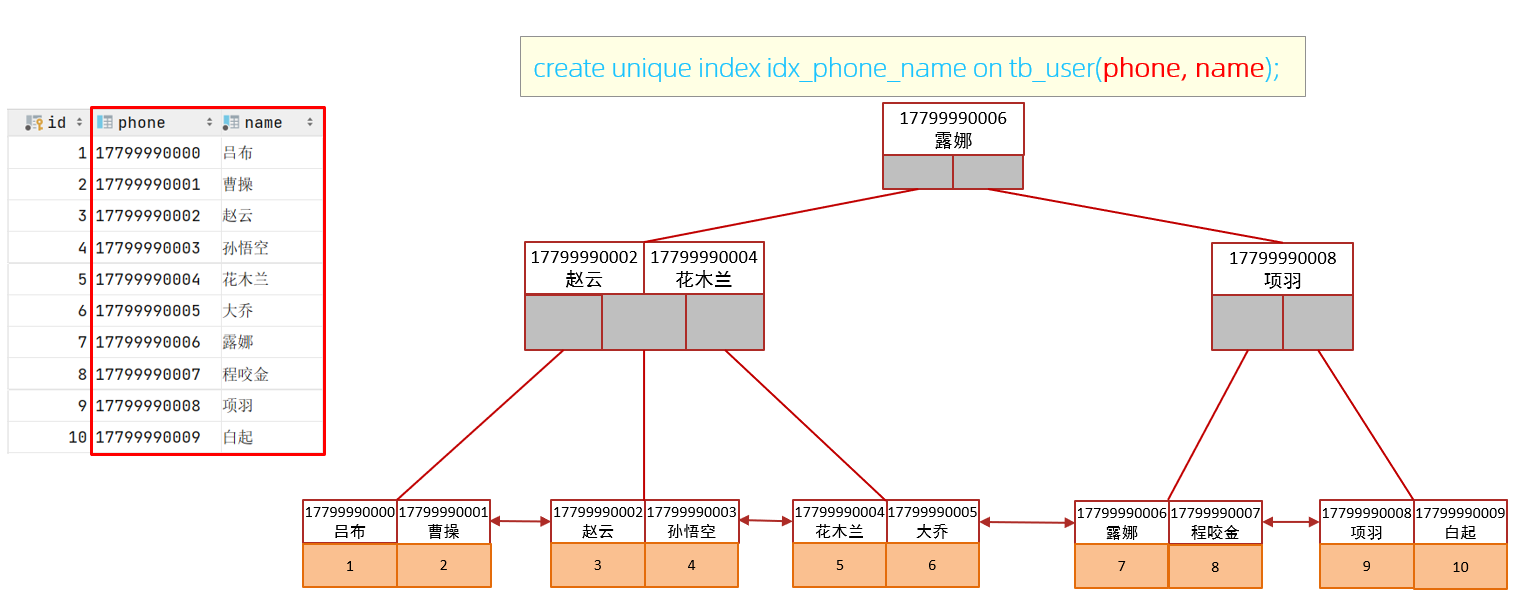thinkphp 做分布式服务+读写分离+分库分表(分区)
- 引言 thinkphp* 大道至简
- 一、分库分表
- 分表
- php 分库分表hash算法
- 0、分表的方法(thinkphp)
- 1、ThinkPHP6 业务分表之一:UID 发号器
- 2、ThinkPHP6 业务分表之二:用户
- 其他杂项
- 1亿条数据在PHP中实现Mysql数据库分表100张
引言 thinkphp* 大道至简
一、分库分表
分表
分表分库一般分垂直和水平,垂直是指感觉业务来进行库的拆分,比如专门的用户库或者订单库这样子,但垂直还是无法解决单表数据量过大导致的性能会差的问题(这里可能会和上面矛盾,网上多数指的是 2000W 就会影响,但好像没有多少人谈过他们的表结构情况)。水平分指的是某一个表,里面的数据量非常大,我们按照一定的规则来进行一个拆分分流,比如把用户的数据由一直存放在用户表,变为可能这条数据是在用户1号表或者2号表这样子。规则可能是 范围(range)或者哈希(hash),也不知道我喜欢的取模算不算哈希。分了其实会带来一些问题的复杂性,比如分库那如何确保多库事务性的一致性、分布式锁等等很多,然后还有之前我们的 join 查询,现在可能就无法使用呢。
php 分库分表hash算法
app/common.php 公共方法定义
$userid 也可以用下面的uid 发号器定义,通过哈希来就算出表名称
//哈希分表
function get_hash_table($table, $userid) {
$str = crc32($userid);
if ($str < 0) {
$hash = "0" . substr(abs($str), 0, 1);
} else {
$hash = substr($str, 0, 2);
}
return $table . "_" . $hash;
}
控制器调用计算表名
public function index() {
echo $table=get_hash_table('message', '18991').'<br>';
echo $table=get_hash_table('message', '18993').'<br>';
echo $table=get_hash_table('message', '18994').'<br>';
}
0、分表的方法(thinkphp)
public function getPartitionTableName($data=array()) {
// 对数据表进行分区
if(isset($data[$this->partition['field']])) {
$field = $data[$this->partition['field']];
switch($this->partition['type']) {
case 'id':
// 按照id范围分表
$step = $this->partition['expr'];
$seq = floor($field / $step)+1;
break;
case 'year':
// 按照年份分表
if(!is_numeric($field)) {
$field = strtotime($field);
}
$seq = date('Y',$field)-$this->partition['expr']+1;
break;
case 'mod':
// 按照id的模数分表
$seq = ($field % $this->partition['num'])+1;
break;
case 'md5':
// 按照md5的序列分表
$seq = (ord(substr(md5($field),0,1)) % $this->partition['num'])+1;
break;
default :
if(function_exists($this->partition['type'])) {
// 支持指定函数哈希
$fun = $this->partition['type'];
$seq = (ord(substr($fun($field),0,1)) % $this->partition['num'])+1;
}else{
// 按照字段的首字母的值分表
$seq = (ord($field{0}) % $this->partition['num'])+1;
}
}
return $this->getTableName().'_'.$seq;
}else{
// 当设置的分表字段不在查询条件或者数据中
// 进行联合查询,必须设定 partition['num']
$tableName = array();
for($i=0;$i<$this->partition['num'];$i++)
$tableName[] = 'SELECT * FROM '.$this->getTableName().'_'.($i+1);
$tableName = '( '.implode(" UNION ",$tableName).') AS '.$this->name;
return $tableName;
}
}
1、ThinkPHP6 业务分表之一:UID 发号器
我们现在假设项目是新成立的,暂时没有一个技术债。目前我们要先规划一个用户表,打算划分 16 个表,按照取模的方式来查询。最先可能我们要考虑如何定义 UID 的问题,不过对我们 PHPer 来说不是什么难事,毕竟我们基本都不用 UUID 来做 UID 的,占用的空间会比较多,不利于索引。
但是不用 UUID ,选择了 INT 来做 UID,那我们要如何确保它的连续性和唯一性呢?业内常用的可能是雪花算法,但我选择自己写一个简易的发号器。
发号器需要加东西,然后取东西,我们可以利用 Redis List 来很好的实现我们需要的先进先出功能。通过一个命令或者说脚本,我们定时往列表中填上自增的 ID,然后在注册流程中来取最前面的。

代码层面
app/common.php 公共方法定义获取redis 的值
if(!function_exists('get_redis')) {
function get_redis() {
return new \Predis\Client('tcp://IP:端口', [
'parameters' => [
'password' => '密码',
],
]);
}
}
定义一个发号器函数
app/command/GenerateUID.php
<?php
declare (strict_types = 1);
namespace app\command;
use think\console\Command;
use think\console\Input;
use think\console\input\Argument;
use think\console\input\Option;
use think\console\Output;
class GenerateUID extends Command
{
protected $redis;
/*
* 发号器列表 键
*
* @var string
*/
protected $cache_key = 'generate:uid';
/*
* 锁 键
*
* @var string
*/
protected $lock_key = 'generate:uid_lock';
/*
* 发号器列表最大容量,默认为 500000
*
* @var int
*/
protected $max_capacity = 5E5;
public function __construct()
{
$this->redis = get_redis();
parent::__construct();
}
protected function configure()
{
// 指令配置
$this->setName('generate:uid')
->setDescription('生成 UID');
}
protected function execute(Input $input, Output $output)
{
$current_capacity = $this->get_list_length();
// 计算发号器需要增加的数量
$append_capacity = $this->max_capacity - $current_capacity;
$uid_max = $this->get_uid_max();
$output->writeln('当前最大UID:' . $uid_max);
$output->writeln('当前剩余容量:' . $current_capacity);
$output->writeln('最大存储容量:' . $this->max_capacity);
$output->writeln('需要追加容量:' . $append_capacity);
// 如果不需要增加则结束
if($append_capacity === 0) {
return;
}
$data = [];
for($i = 1; $i <= $append_capacity; $i++) {
$data[] = $uid_max + $i;
}
// 把需要加的数据进行分块,方便快速追加
$data = array_chunk($data, 1000);
// 加锁
$lock = $this->redis->executeRaw([
'SET',
$this->lock_key,
1,
'EX',
10 * 60,
'NX',
]);
if($lock !== 'OK') {
$output->writeln('获取锁失败');
return;
}
try {
foreach ($data as $item) {
$this->redis->rpush($this->cache_key, $item);
}
} catch (\Exception $e) {
$output->error($e->getMessage());
} finally {
// 释放锁
$this->redis->del($this->lock_key);
}
}
/*
* 获取发号器列表的长度
*
* @return int
*/
protected function get_list_length() :int
{
return $this->redis->llen($this->cache_key);
}
/*
* 获取当前最大的 UID
*
* @return int
*/
protected function get_uid_max() :int
{
$value = (int) $this->redis->lindex($this->cache_key, -1);
if($value) {
return $value;
}
return 0;
}
}
config/console.php 定义一个打印函数类
<?php
return [
// 指令定义
'commands' => [
...
'generate:uid' => 'app\command\GenerateUID',
],
];
执行命令
$ php think generate:uid
当前最大UID:0
当前剩余容量:0
最大存储容量:500000
需要追加容量:500000
2、ThinkPHP6 业务分表之二:用户
上一篇我们将了 UID 的发号器,那这一篇我们将要去实现用户的注册入库和简单的查询。
首先我们要实现数据表的识别。获取表名称
app/common.php
if(!function_exists('table_name')) {
/*
* 获取表名称
*
* @param string $name 表名
* @param int|null $uid UID
* @return string
*/
function table_name(string $name, ?int $uid = null) {
$support_table = [
'users' => 16, // 表名 => 分表数
];
if(!isset($support_table[$name])) {
return $name;
}
// 如果没有传递 UID,那则需要调用其他方法来获取 UID
if(is_null($uid)) {
$uid = (int) 1;
}
if((int) $uid === 0) {
throw new \Exception('UID 值异常');
}
// 取 UID 和 分表数的模,值转化为小写十六进制
return sprintf('%s_%x', $name, $uid % $support_table[$name]);
}
}
执行写入操作
app/controller/Auth.php
<?php
namespace app\controller;
use app\BaseController;
use think\facade\Db;
use think\helper\Str;
class Auth extends BaseController
{
/*
* 注册接口
*/
public function register()
{
$redis = get_redis();
// 获取最左的值
$uid = $redis->lpop('generate:uid');
// 为空说明列表已经没内容了
if(is_null($uid)) {
return '无法获取 UID';
}
// 获取表名
$table_name = table_name('users', $uid);
// 插入数据
Db::table($table_name)->insert([
'id' => $uid,
'nickname' => '随机生成' . Str::random(),
]);
return '注册成功';
}
}
其他杂项
1亿条数据在PHP中实现Mysql数据库分表100张
当数据量猛增的时候,大家都会选择库表散列等等方式去优化数据读写速度。笔者做了一个简单的尝试,1亿条数据,分100张表。具体实现过程如下:
首先创建100张表:
$i=0;
while($i<=99){
echo "$newNumber \r\n";
$sql="CREATE TABLE `code_".$i."` (
`full_code` char(10) NOT NULL,
`create_time` int(10) unsigned NOT NULL,
PRIMARY KEY (`full_code`),
) ENGINE=MyISAM DEFAULT CHARSET=utf8";
mysql_query($sql);
$i++;
下面说一下我的分表规则,full_code作为主键,我们对full_code做hash
函数如下:
$table_name=get_hash_table('code',$full_code);
function get_hash_table($table,$code,$s=100){
$hash = sprintf("%u", crc32($code));
echo $hash;
$hash1 = intval(fmod($hash, $s));
return $table."_".$hash1;
}
这样插入数据前通过get_hash_table获取数据存放的表名。
最后我们使用merge存储引擎来实现一张完整的code表
1 CREATE TABLE IF NOT EXISTS
code(
2full_codechar(10) NOT NULL,
3create_timeint(10) unsigned NOT NULL,
4 INDEX(full_code)
5 ) TYPE=MERGE UNION=(code_0,code_1,code_2…) INSERT_METHOD=LAST ;
这样我们通过select * from code就可以得到所有的full_code数据了。















![[OpenGL]使用OpenGL绘制带纹理三角形](https://i-blog.csdnimg.cn/direct/91a06c6a10f34ec6aa4d579d922d7328.png#pic_center)


